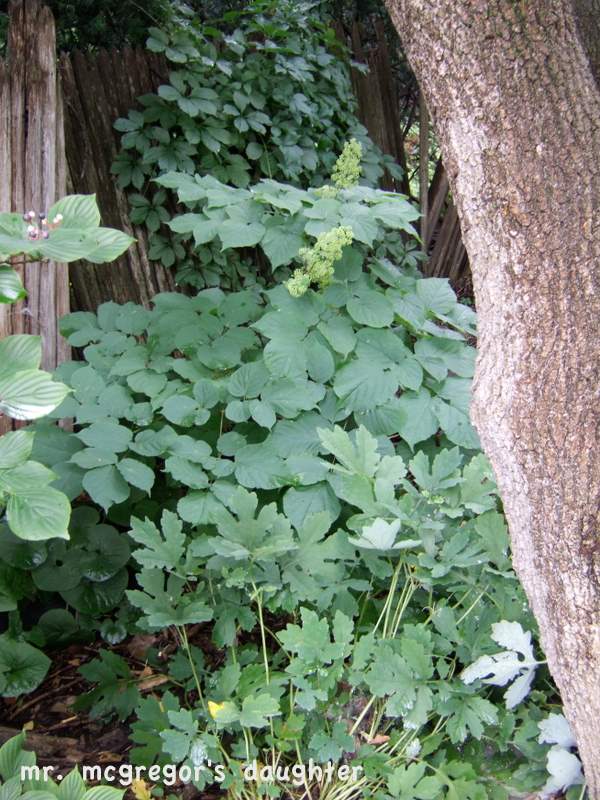Professor Penumbra here, to enlighten you about the challenge of gardening in dry shade. It is not all doom and gloom. We will use the garden of Squirrelhaven as our model.Every year, unless there is near constant rainfall, the soil of the garden and lawns of Squirrelhaven dries out so completely that it develops large cracks. This spring alone, despite the moisture from the melting of snow and the abundance of spring rain, the garden and lawn already began to crack from a mere 10 days without measurable rainfall, going from squishy and too wet to plant, to parched and too dry to plant in about a week. Such conditions are too inhospitable for Astilbes. By August, the leaves are typically brown and blooming may be stunted or absent. Yearly, the Aruncus has decreased in size. If it hadn't been for two back-to-back wet summers, it would probably have died already. It has long since ceased to bloom. The gardener here insists on growing Caulophyllum thalictroides for sentimental reasons, even though it prefers more moist conditions than that in which it finds itself. By midsummer, its foliage is usually starting to tatter.

Astrantias don't bloom nearly as long as they should. Don't even think about planting those bold foliaged moisture-loving plants Ligularias and Rodgersia here. They probably wouldn't survive a season.So you must be wondering what can be grown in dry shade? Two of the stalwarts of Squirrelhaven may surprise you: Hostas and Daylilies (Hemerocallis hybrids).

Both prefer more moisture, but will perform adequately in dryness, and, while the Daylilies don't bloom as profusely in shade, the blooms hold their color better. Another surprising couple of performers are the Lobelias 'Monet Moment'

and L. syphilitica. Despite the dryness, they bloom for a couple of months. Heucheras, Heucherellas, and Tiarellas perform well in dry conditions, appreciating the good winter drainage. For groundcovers, Epimediums, Wild Gingers (Asarum canadense), Lady's Mantle (Alchemilla mollis),

and Labrador Violets (Viola labradorica) thrive here. Columbines do very well,

as do Peach-leaved Bellflowers (Campanula perscifolia),

both seeding freely.

The native woodlanders Solomon's Seal (Polyganatum species), Solomon's Plume (Maianthemum racemosum/Smilacina racemosa), Anemonella thalictroides (Thalictrum thalictroides), and Geranium maculatum all perform well without much moisture, while the native Celadine Poppy tends to die back in the middle of a dry summer, rather than continuing to bloom, and the foliage of Sanguinaria canadensis dies back earlier.

For autumn bloom, Japanese Anemones and the native Woodland Aster (formerly Aster divaricata) do very well and Monkshood (unknown Aconitum species)

manages to provide a good show. The best performing Fern here is the evergreen Christmas Fern.

Hellebores thrive in the dry shade, even the fussy Christmas Rose (H. orientalis).Shrubs for dry shade are more of a challenge. Evergreens seem to fare the best. Boxwood (Buxus of unknown species), has thrived here, freely reseeding. Yew also does very well, despite the winter predations of deer. Thujas, both occidentalis and plicata, tolerate the shade and dryness, growing more slowly than in moister conditions. Of deciduous shrubs, the best performer is Oakleaf Hydrangea (Hydrangea quercifolia),

blooming and sporting autumnal foliage color despite the lack of moisture. Cornus alternifolia performs adequately, but its fall color suffers from the dryness.The two wet summers have revealed a positive side to dry shade. It has kept in check some plants in need of it. Before those wet summers, the Japanese Anemone (Anemone x hybrida 'Andrea Atkinson') was well behaved and stayed in its beds. During and after those summers, it has begun sending out long, deep runners, crowding other plants and popping up in the middle of the paths. The native Spikenard (Aralia racemosa), is planted in a confined area.

The dryness kept it at a manageable 3 feet; after wet summers, it has soared upward and outward, obstructing the path. The extra moisture has turned Aster tataricus into a raging beast, forcing the gardener to remove vast quantities of it. Even Goutweed, which was growing here when I bought the property, was kept in check until I dug it all out.Clearly, there is no need to despair of dry shade. While challenging, a garden can grow and bloom in such conditions.This post is part of Design Workshop at Gardening Gone Wild.